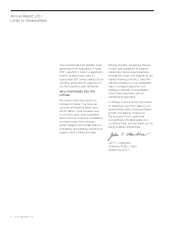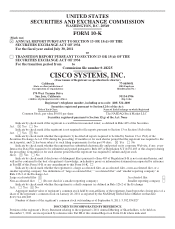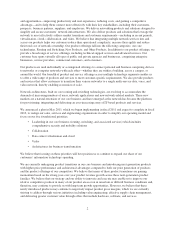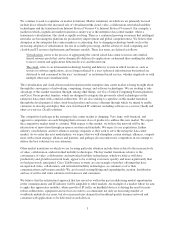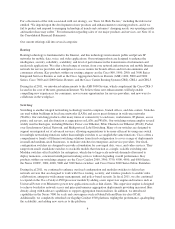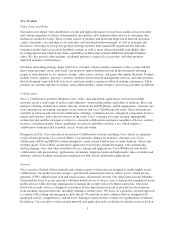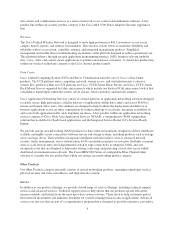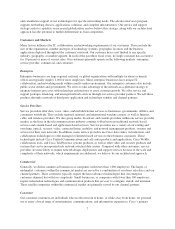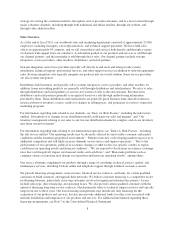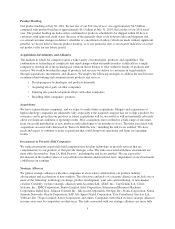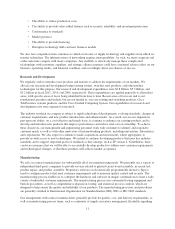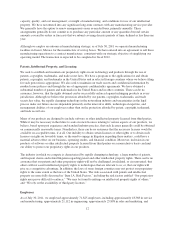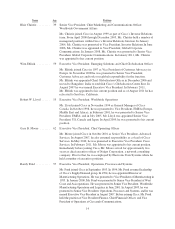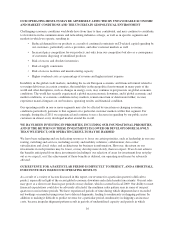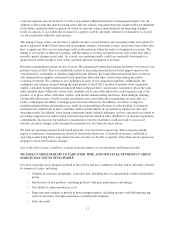Cisco 2011 Annual Report Download - page 15
Download and view the complete annual report
Please find page 15 of the 2011 Cisco annual report below. You can navigate through the pages in the report by either clicking on the pages listed below, or by using the keyword search tool below to find specific information within the annual report.and consultative support of our technologies for specific networking needs. The advanced services program
supports networking devices, applications, solutions, and complete infrastructures. Our service and support
strategy seeks to capitalize on increased globalization, and we believe this strategy, along with our architectural
approach, has the potential to further differentiate us from competitors.
Customers and Markets
Many factors influence the IT, collaboration, and networking requirements of our customers. These include the
size of the organization, number and types of technology systems, geographic location, and the business
applications deployed throughout the customer’s network. Our customer base is not limited to any specific
industry, geography, or market segment. In each of the past three fiscal years, no single customer has accounted
for 10 percent or more of our net sales. Our customers primarily operate in the following markets: enterprise,
service provider, commercial, and consumer.
Enterprise
Enterprise businesses are large regional, national, or global organizations with multiple locations or branch
offices and typically employ 1,000 or more employees. Many enterprise businesses have unique IT,
collaboration, and networking needs within a multi-vendor environment. Our enterprise customers also include
public sector entities and governments. We strive to take advantage of the network-as-a-platform strategy to
integrate business processes with technology architectures to assist customer growth. We offer service and
support packages, financing, and managed network services through our service provider partners. We sell these
products through a network of third-party application and technology vendors and channel partners.
Service Providers
Service providers offer data, voice, video, and mobile/wireless services to businesses, governments, utilities, and
consumers worldwide. They include regional, national, and international wireline carriers, as well as Internet,
cable, and wireless providers. We also group media, broadcast, and content-providers within our service provider
market, as the lines in the telecommunications industry continue to blur between traditional network-based
services and content-based and application-based services. Service providers use a variety of our routing and
switching, optical, security, video, connected home, mobility, and network management products, systems and
services for their own networks. In addition, many service providers use Cisco data center, virtualization, and
collaboration technologies to offer managed or Internet-based services to their business customers. These
technologies include Cisco Unified Communications and call center products and applications, Cisco WebEx
collaboration tools, and Cisco TelePresence systems products, as well as other video and security products and
systems that can be incorporated into network-attached data centers. Compared with other customers, service
providers are more likely to require network design, deployment, and support services because of the scale and
complexity of their networks, which requirements are addressed, we believe, by our architectural approach.
Commercial
Generally, we define commercial businesses as companies with fewer than 1,000 employees. The larger, or
midmarket, customers within the commercial market are served by a combination of our direct salesforce and our
channel partners. These customers typically require the latest advanced technologies that our enterprise
customers demand, but with less complexity. Small businesses, or companies with fewer than 100 employees,
require information technologies and communication products that are easy to configure, install, and maintain.
These smaller companies within the commercial market are primarily served by our channel partners.
Consumer
Our consumer customers are individuals who use the network at home, or while away from home, for personal
use to enjoy a broad range of entertainment, communications, and information experiences. Cisco’s primary
7



